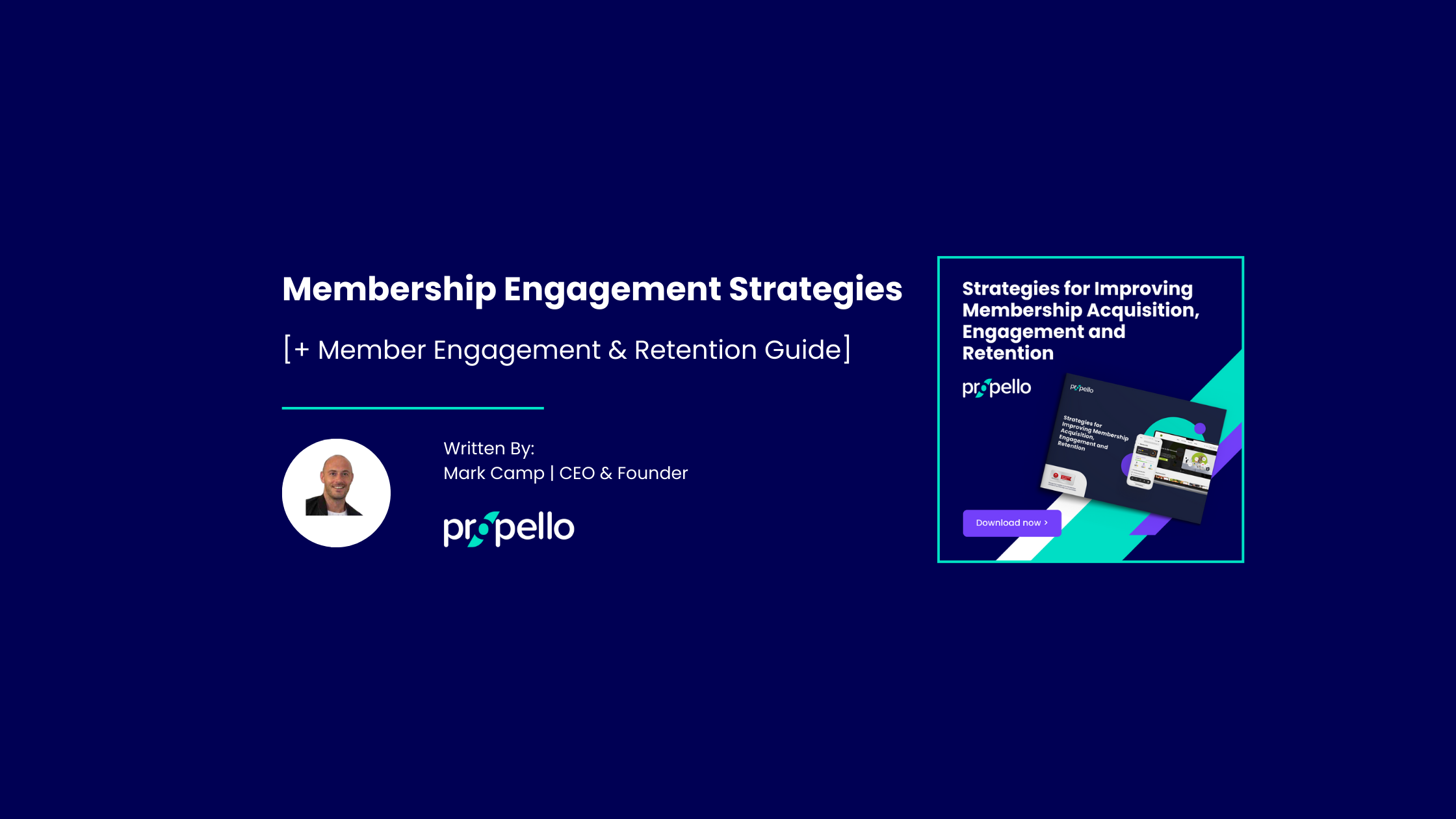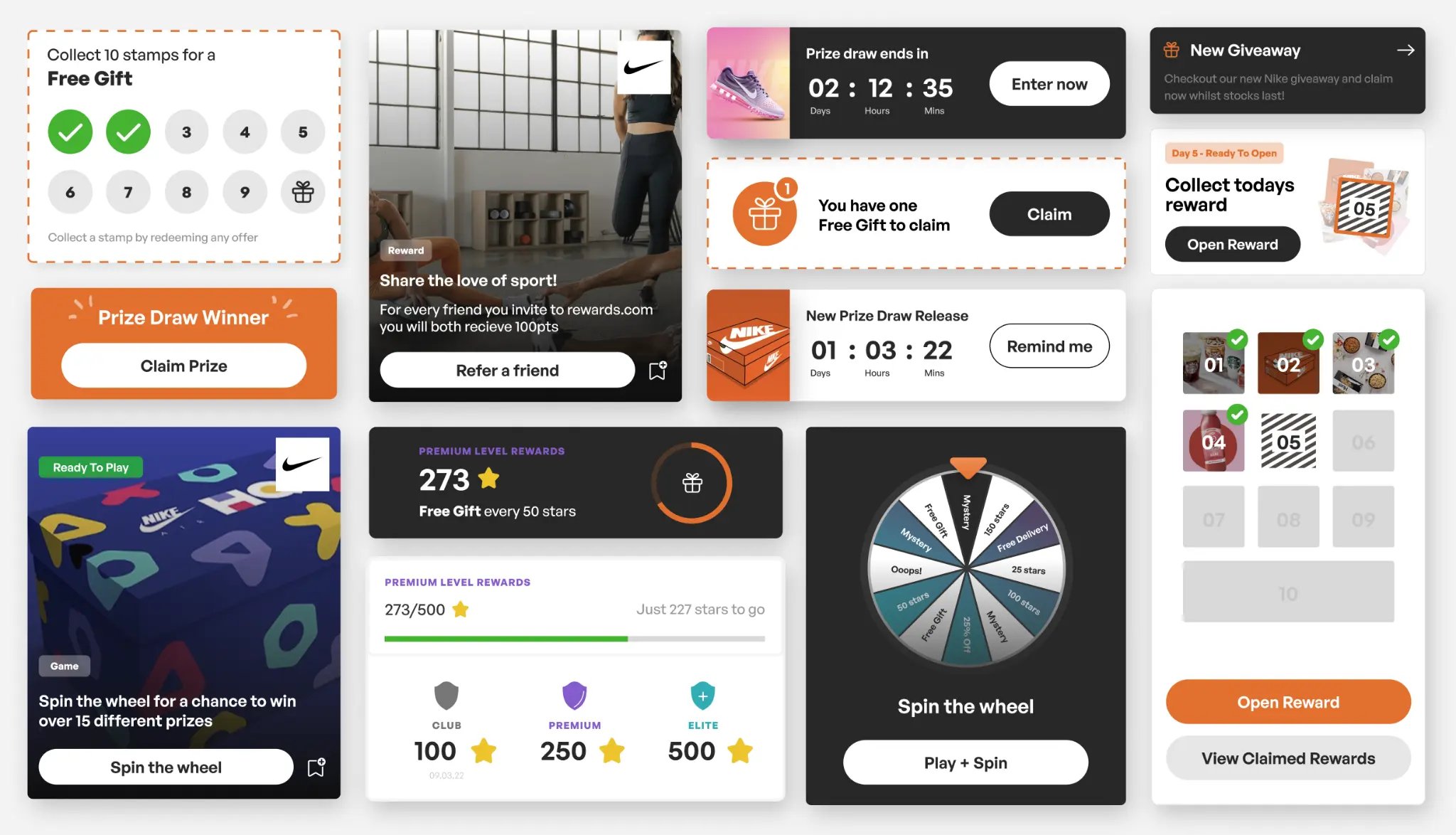-
NASWUT (National Association of Schoolmasters Union of Women Teachers) uses similar brand partnerships to provide practical value that complements their core union services. Offering relevant and valuable rewards increases redemption rates and encourages members to engage with the organisation.
5) How Does Better Use of Data Improve Engagement?
Data transforms guesswork into precision. When you understand what members actually do (not only what they say they want), you can create engagement touchpoints that feel personally relevant rather than generic.
Most organisations recognise the gap...
44% want better use of data, as accurate data allows for refined segments, aligning experiences, rewards, and wider value propositions to member preferences.
Propello Cloud Membership Organisation Report
But a crucial challenge remains: using collected data strategically.
How can you turn data insights into action?
Track engagement patterns to identify members drifting toward inactivity before they decide to leave. Segment by behaviour: early-career professionals engaging with training content need different nudges than senior members seeking networking opportunities.
Use data to trigger timely interventions:
- a personalised email when someone completes their first course,
- reward unlocks after three event attendances, or
- targeted re-engagement campaigns for members showing warning signs of churn.
The shift from intuition to evidence-based decisions means you're investing resources where they'll drive the strongest engagement outcomes and member satisfaction.
6) How Can Events Strengthen Member Communities?
Events strengthen communities through lasting human connections. They transform your membership from a list of contacts into a genuine community where people build lasting professional relationships.
Over 30% of associations are planning more events and community initiatives.
Propello Cloud Membership Organisation Report
Build micro-communities within events
You can get even closer to your audiences with micro-communities in your events via:
- Interest-specific breakout sessions for specialities or career stages
- Local chapter pods connecting those members located in the same state or area of the world
- Peer mentoring circles allowing amateurs to learn from more experienced professionals
These intimate settings encourage deeper conversations than large plenary sessions.
Spread event engagement across your calendar
Your annual conference shouldn't carry the entire community-building load. Regular virtual coffee chats between major events maintain momentum. Quarterly regional meetups strengthen local connections. Your flagship event becomes the highlight, not the only touchpoint.
7) How Do You Personalise Member Journeys Starting With Onboarding?
Gather member data points like demographics, interests, behaviours, and preferences from surveys, CRM systems, and analytics. Then use their shared characteristics to divide your member base into distinct groups and create tailored experiences for each one.
For example:
- personalised onboarding plans for new signups, and
- tailored member journeys (ongoing communications, content, and recommendations) for existing members.
We’re now seeing membership trends that associations follow this approach to engage members.
42% of organisations now deliver personalised digital experiences, according to Memberwise.
But some still use static member profiles that do not respond to dynamic behaviour.
Forward-thinking associations, however, use AI and machine learning to anticipate these behavioural changes and potential interest areas. When a member repeatedly engages with leadership content, the system automatically recommends mentorship programmes and leadership resources.
The proactive approach improves engagement with immediate and ongoing value. Members feel supported, and the targeted recommendations lead them on a journey of progressive disclosure based on real-time behaviour.
8) How do Referral Programmes Boost Member Acquisition and Engagement?
Referral programmes are successful because they leverage trust. Your happiest members share what they love about your organisation to get other members to join.
87% of people trust friend and family recommendations over any marketing message you could create.
These referred leads also typically have a higher conversion rate (30%) and lifetime value (16%) when compared to leads you get from other marketing channels.
Double-sided rewards create win-win scenarios. Your referrer could earn conference discounts, and their referred friend could get a trial rate for the first year’s subscription.
Don't treat referrals as isolated transactions. Weave them into your gamification and loyalty systems. Members who successfully refer three people could unlock "Ambassador" status with exclusive networking access.
This integration turns one-off referrals into ongoing engagement opportunities that deepen member investment in your community.
Monitor these key metrics to optimise your programme:
-
Referral conversion rates for each member segment
-
Time taken from accessing the website to completing the membership sign-up
-
Long-term retention rates for referred members
Modern referral software automates the reward process, eliminating manual administration while ensuring referrers get recognised immediately when their contacts join.
The most effective referrals happen organically when members genuinely love what you offer. Focus on creating experiences worth sharing rather than pushing people to refer. When members feel excited about your value, sharing becomes a natural extension of their enthusiasm.
9) How Do You Communicate Effectively With Members?
Adopt a multi-channel approach to reach members where they are. Executives might prefer short updates on LinkedIn, while your newer additions want in-depth guidance in an email. Some respond better to phone calls; others want self-service options.
Email remains your strongest channel. According to the MGI Benchmarking Report, all membership organisations (100%) use email as part of their renewals strategy, and 84% listed it as the most effective channel. But effectiveness falls sharply without trust.
Developing trust through consistent communication involves:
- Frequency without fatigue: Regular touchpoints that add value rather than noise
- Prompt responses: Quick responses to queries when members reach out
- Clear and straightforward updates: Openly communicating your wins and struggles
It's all in your feedback loops, which turn basic communication into meaningful conversation. Close the loop by demonstrating to members how their suggestions influenced key decisions.
When you show members their voices are making a real difference, they become part of a community dialogue that drives deeper engagement at every touchpoint.
10) How Can Digital Platforms Drive Member Engagement?
Your digital platforms need to work together, not operate in silos. When members share valuable insights on LinkedIn, pull those conversations into your community forums. Use social media activity to spark deeper discussions and inform your content strategy.
This creates momentum where engagement on one platform amplifies participation across your entire digital ecosystem.
When members need separate logins for events, resources, and profile updates, they stop participating. They miss opportunities and start questioning whether your organisation understands modern user experience.
Successful digital ecosystems resolve those issues with:
-
Universal sign-in across your site, learning platform, and mobile app
-
Live data synchronisation, meaning that member preferences update everywhere at the same time
-
Unified analytics to monitor member interaction at all touchpoints
When you remove integration barriers, members move fluidly between your platforms. They attend more events because registration is effortless. They complete more courses because progress syncs automatically. They participate in discussions because their preferences follow them everywhere.
11) How Can Feedback Improve Your Engagement Strategy?
Boost engagement by collecting feedback throughout the member journey, not just annually. Quick two-question polls after webinars capture immediate reactions. Exit surveys from departing members reveal why people leave. Website analytics show what content truly resonates before you ask anyone.
MemberWise data shows 68% of organisations now use online survey tools to gauge engagement. But collecting feedback is only half the battle, acting on it creates the real value.
| Method to Measure Engagement | % |
| Online Survey Tools | 68% |
| Email Marketing Tools | 67% |
| Website Content Management System Analytics | 48% |
| Learning Management Scoring Tool | 29% |
| Member Engagement Scoring Tool | 26% |
| Online Community Analytics Platform | 18% |
Use multiple data sources
Combine different feedback types for accurate insights:
- Surveys tell you what members think they want
- Analytics reveal what they actually do
- Forum discussions expose unfiltered opinions about industry issues
Make your response visible
Members expect to see results when they share feedback. Show them their voices matter through:
- Concrete examples of how recommendations shaped specific changes
- Quick wins that demonstrate your responsiveness
- Clear explanations when suggested ideas can't be implemented
Let member behaviour guide your strategy
Analytics often reveal patterns that surveys miss completely. When members consistently drop out of online courses at the 15-minute mark, that's more actionable than asking them to rate course quality.
12) How Do Advocacy and Social Impact Drive Engagement?
Advocacy and social impact transform your membership from a simple transaction into a shared mission. When members rally together for causes they believe in, they become active champions of professional change.
This shift creates powerful emotional investment. Members who fight for legislative reforms or industry standards feel genuine ownership in the outcomes.
Values alignment drives participation
Your advocacy efforts must reflect what your members truly care about. MGI data shows supporting advocacy ranks as a top reason professionals join associations, especially in trade groups where collective action creates industry-wide change.

The community-building potential within your diversity, equity and inclusion efforts is stronger when you offer meaningful opportunities for participation.
Mentoring programmes that match people across categories help develop relationships and careers at the same time. A wide range of event speakers also encourages diversity of viewpoints and backgrounds within your community.
Mobilise through focused action
Effective grassroots strategies give members clear, achievable ways to make a difference through:
-
Specialist groups working in particular challenge areas
-
Legislative action alerts that describe exactly what members can do
-
Community impact projects that show collective impact
This advocacy-driven engagement sustains itself because members feel personally invested in outcomes they helped create.
13) How Does Content Creation Build Member Engagement?
Quality content creates ongoing touchpoints that bring members back to your organisation regularly. When you address real challenges with practical solutions, members see you as their go-to resource rather than just another membership subscription.
But your content strategy must address real member issues. Timely guidance videos deliver instant value when your audience is grappling with new regulations. Write clear explainer articles that establish your expertise in complex industry topics.
Different content types serve different purposes:
-
Educational webinars develop expertise and offer a live interaction channel
-
Case studies generated by members from their own experience of peer successes and practical applications
-
Quick industry updates to keep pace with busy schedules
-
Troubleshooting discussion boards to compare notes on overcoming obstacles
Watch which articles create forum topics. Keep track of whether members who have read one or more pieces of content have attended an event around that topic. See if particular themes generate membership enquiries or renewal discussions.
Content that invites members to participate—whether through comments, shares, or discussion threads—creates long-term engagement beyond the initial moment of consumption.
How Should You Measure and Optimise Member Engagement?
Track metrics that reveal whether your engagement efforts actually drive the behaviours you want to see. Effective measurement connects member activities to meaningful outcomes.
Focus on four key areas:
-
Participation patterns: Monitor login frequency, content consumption, event attendance rates, and community activity. These show how actively members use your offerings.
-
Retention indicators: Track churn rates, renewal percentages, average membership duration, and Net Promoter Scores. Strong engagement should translate to longer, more loyal relationships.
-
Value perception: Measure satisfaction scores, benefit usage rates, and partnership programme redemptions. Members who see clear value engage more consistently.
-
Growth metrics: Calculate membership growth rates, member acquisition costs, and member lifetime value. Engaged communities attract new members and generate sustainable revenue.
Make it actionable
Review these metrics monthly, not annually. Look for patterns that connect specific engagement activities to retention improvements. When you spot declining participation in certain areas, investigate quickly and adjust your approach.
Your main goal should be understanding which activities create the strongest member relationships and doubling down on what works.
Start Building a Thriving Membership Community Today
Associations that invest in a membership engagement strategy have just one thing on their menu: long-term prosperity. Meanwhile, outdated approaches will only bring about a loss of relevance.
-
Your value proposition is about human connections. Free online learning or AI tools can never replace peer relationships in the industry, credibility within one's own profession, or collectively advocating for common interests.
-
Start with just one strategy that will close your biggest engagement gap. If you're taking on new members and the onboarding process is chaotic, then before embarking on anything complex, straighten this out.
Membership growth for organisations starts with engaging the members you already have. It's no longer a matter of whether or not to invest in member engagement. The question is how soon you can start.
FAQs
What are the key components of a successful member engagement strategy?
Personalised experiences, loyalty programmes, integrated digital platforms, regular feedback, and community-based activities all contribute to success. Provide value at all touchpoints to create memorable interactions that promote positive member sentiment.
How can I measure the effectiveness of my membership engagement efforts?
Track renewal rates by engagement level, first-year retention, which platforms members are most active on, and satisfaction scores. Link activity metrics to the actual business results rather than just vanity metrics.
What are best practices for increasing member retention through engagement?
Segment by behaviour, personalise the member experience, react quickly to feedback, provide connections among peers, and make sure you constantly demonstrate value. Early engagement leads to long-term retention.
How do I personalise member engagement to target different segments?
Use behaviour data together with demographics. Track what content members are consuming, which events they go to, or which platform they use. Automatically provide suggestions that are related to what their interests have indicated.
What role does content play in member engagement?
Content creates regular points of contact which will bring members back. Create relevant content that resolves actual day-to-day problems, creates opportunities for peer discussions, and provides practical value rather than promotional content.
How can automation improve engagement without losing the human touch?
Automate tasks like welcome sequences and reminders for renewal, but keep all complicated interactions human. Use AI to personalise member experiences, not as an alternative to strategies that promote relationship-building with your members.
How can I re-engage inactive or at-risk members?
Find warning signals early through engagement scoring. Get in touch personally before they drop out. Provide different avenues for them to share their feedback and input and make changes to reflect their perspective of membership value.
How do events and community-building activities help increase engagement?
Mix formats – both virtual and in person. Create micro-communities around specific interests. Include active volunteer opportunities and engagement opportunities that occur throughout the year, not just during annual conferences.
What innovative technologies can improve engagement?
AI for predictive personalisation, integrated digital ecosystems, mobile apps with real functionality, and automated engagement scoring are excellent examples. But robust integration is crucial for success. These systems must communicate in real time to keep processes smooth.
How can member feedback be incorporated into engagement strategies?
Collect feedback via multiple channels continuously. Act on suggestions so that members can see that their opinions matter. And make use of both surveys and behaviour analytics for a full picture of your members’ true needs and preferences.
Author Bio, Written By:
Mark Camp | CEO & Founder at PropelloCloud.com | LinkedIn
Mark is the Founder and CEO of Propello Cloud, an innovative SaaS platform for loyalty and customer engagement. With over 20 years of marketing experience, he is passionate about helping brands boost retention and acquisition with scalable loyalty solutions.
Mark is an expert in loyalty and engagement strategy, having worked with major enterprise clients across industries to drive growth through rewards programmes. He leads Propello Cloud's mission to deliver versatile platforms that help organisations attract, engage and retain customers.











.png)